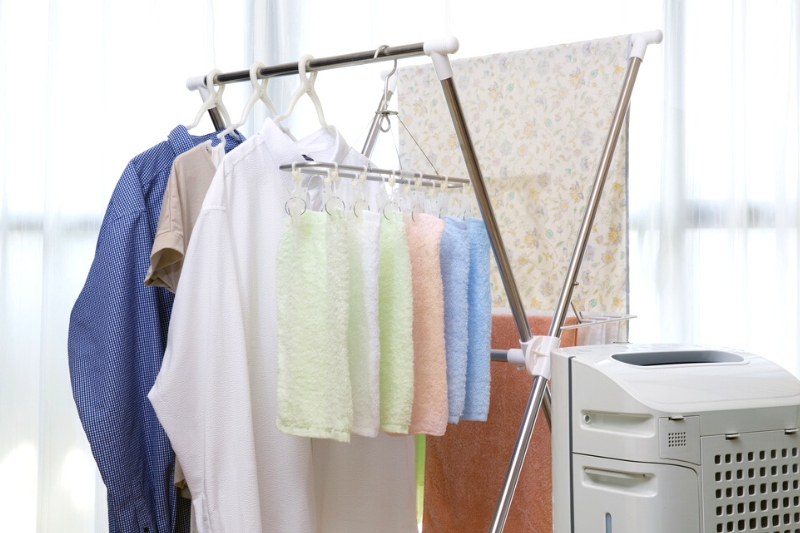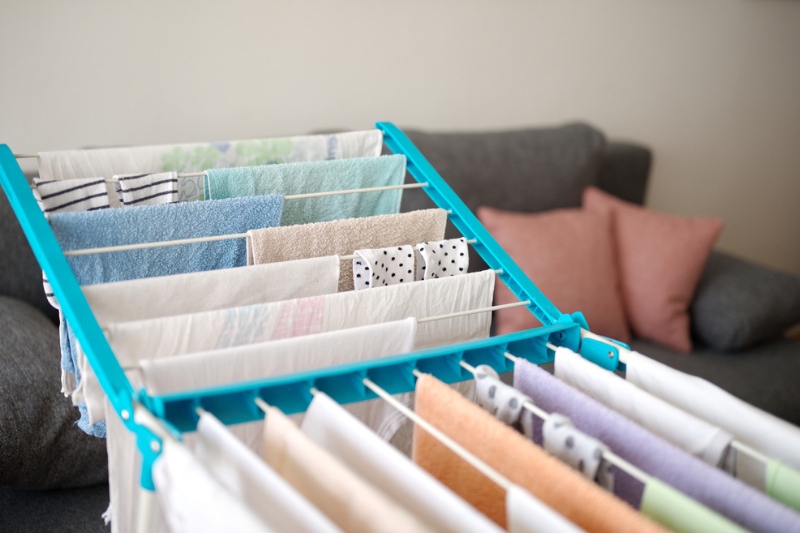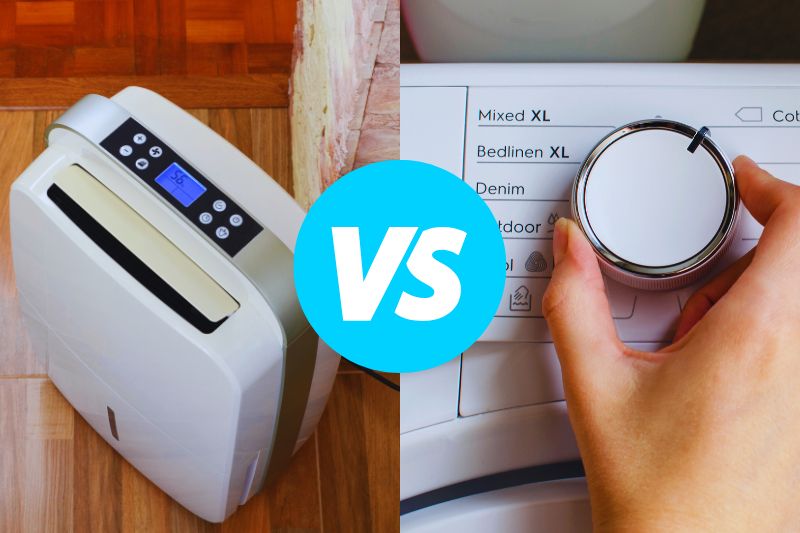Drying clothes can be straightforward if you have the outside space and good weather conditions.
However, the UK weather is often wet and cold, and people living in flats have no choice but to dry their clothes indoors. That can create a dilemma about the best way to do it.
One way is to go to a launderette, but that can be costly and may involve a long trip with wet clothes.
One alternative is to drape clothes over radiators or a clothes airer, which can lead to a damp atmosphere and an untidy appearance unless you can confine this to a spare room.
A heated airer or drying rack may do the job quicker but still has the same drawbacks of creating damp.
Sometimes the options come down to a choice between using a tumble dryer or a dehumidifier to do the job and each has its benefits and disadvantages.
Using a Dehumidifier to Dry Clothes

The main purpose of a dehumidifier is to remove excess moisture from the atmosphere, generally to avoid problems caused by dampness, such as mould on walls and poor health conditions.
However, many modern dehumidifiers have a laundry mode designed for helping dry washing.
Manufactures claim that running costs are lower than for tumble dryers and, in cash-strapped times, some owners see it as an opportunity to remove moisture from the air and their wet clothes at the same time.
The chosen method is generally to put the washing on a clothes airer in the same room as the dehumidifier.
Using a Tumble Dryer to Dry Clothes

A tumble dryer is, of course, specifically dedicated to drying clothes. However, there are decisions to be made when buying a new one:
- If possible, get a heat pump dryer since they are the most energy efficient type of tumble dryer. However, they are more expensive than condenser and vented models.
- Condenser dryers collect moisture from clothes in a tank, which needs to be emptied of water periodically. They are reputed to be more prone to breakdown than vented models due to their added complexity and can take longer to dry a load than a vented dryer, so consider carefully before choosing.
- A vented dryer takes all the moisture out of the house, either through a hole in the wall or by hanging the outlet pipe out of a window.
- A model with a sensor will have different drying settings and will stop automatically when the clothes are dry enough, saving energy.
Running Time and Cost
The running times and running costs of tumble dryers and dehumidifiers vary a lot depending on the model and how it is used. However, the general view is that a tumble dryer will dry a load in about 40 minutes while a dehumidifier in laundry mode takes about 3-5 hours.
According to dehumidifier manufacturer Pro Breeze, their PB-06-AE 12L Dehumidifier costs as little as 5p an hour to run. This means if it takes 5 hours to dry your clothes, this would cost 25p.
The running costs of a tumble dryer vary depending on the type of dryer. A vented or condenser tumble dryer is likely to cost around £1.30 per cycle to run, whereas a heat pump tumble dryer would only cost about 50p per cycle.
Based on these figures, dehumidifiers are cheaper to use than tumble dryers for drying clothes, even when compared to the most energy efficient tumble dryers.
Dehumidifiers are also cheaper to buy up front compared to tumble dryers. While the most expensive dehumidifiers cost more than the cheapest tumble dryers, on average dehumidifiers are significantly cheaper to buy.
Practicality
One way that tumble dryers beat dehumidifiers is that they are easier and quicker to use.
Once your washing is done, simply remove items that aren’t tumble dryer safe, make sure your clothes aren’t tangled, and then put them in the tumble dryer.
With dehumidifiers, you need to set up a drying rack and arrange your clothes on it.
You should also dry clothes in a separate room because it would be unhealthy to sit breathing in the damp air while your clothes dry. This makes using a dehumidifier a bit less practical.

Summary of Pros and Cons
Here’s a summary of the pros and cons of using both a tumble dryer and a dehumidifier to dry clothes.
Dehumidifier
Pros
- Cheaper to run and more energy efficient
- Gentler on clothes – won’t damage clothes or cause shrinkage
- Can also be used to reduce humidity and thereby reduce the risk of damp and mould forming in your home.
- Can be used to dry all kinds of clothes, including delicates
Cons
- Takes longer to dry clothes
- Ideally you need to dedicate a room you won’t use to drying clothes – it would be unhealthy to sit next to your drying clothes while they are damp.
- You also need a clothes airer to use this method
Tumble dryer
Pros
- Dries clothes quickly
- No need to arrange clothes on a clothes airer – just chuck them in the dryer
Cons
- Uses more electricity and costs more to run
- Can damage clothes
- Not all clothes are suitable for tumble drying

In The Wash is your guide to the best laundry and cleaning products, tips and tricks. Our mission is to solve the UK’s cleaning and laundry dilemmas!






